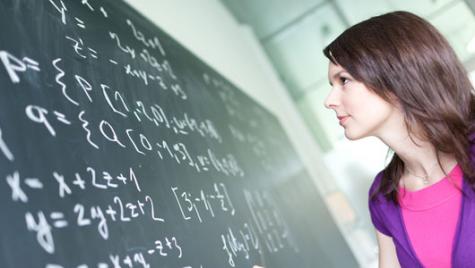So much of politics and sport have been taken up in recent weeks with gender issues.
The Prime Minister and her Women for Gillard movement; the conflation of a Tony Abbott-led Liberal Government, blue ties and abortion on demand; former radio presenter, Howard Sattler, and his irrelevant and obnoxious questions to the Prime Minister; the excruciatingly cringeworthy menu at the Mal Brough fundraiser; and the Latin-speaking German coach of the Socceroos, Holger Osieck, who says that something was lost in translation when he made a comment about the place of women.
But yet we ignore important issues of gender representation and differences right where it starts to skew one way or the other - in the classroom.
Next month, 23 of Australia’s top high school science, mathematics and informatics students will strive for gold medals when they represent Australia at the UNESCO-sanctioned International Science and Mathematical Olympiads. Only one is a girl.
The Olympiads are annual worldwide competitions for exceptionally talented school students from more than 100 countries. It’s a great opportunity for these top-performing students to develop their talents in science and mathematics and, hopefully, encourage them to become the next generation of scientists, mathematicians, engineers and medical researchers.
“The International Olympiads are highly prestigious international events which expose our students to exciting new developments in the science arena and allow them to build international networks that will be invaluable in their future careers as science leaders,” according to Adjunct Professor Mike Clapper of the Australian Mathematics Trust and the University of Canberra.
As well as the low representation from girls, only three States (NSW, Victoria and WA) are represented; and only one student is from a school out of a metropolitan area.
A/Professor Clapper says these are pertinent issues.
“Statistics from the Australian Mathematics Competition, which is our baseline open competition, show that girls do as well as boys [in maths]. However, at the very top end, they are under-represented.”
He says this means that there are more boys than girls in the higher-end competitions with Australia having an average of one girl per year out in the six-person Maths team over the last eight years. He notes that the same is true in many other countries.
“Yet the top-performing student in the last four International Maths Olympiads is a German girl, Lisa Sauerman.”
A/Professor Clapper believes it is a cultural issue, rather than an intellectual one.
“I know from my own experience in schools that there are many girls more than capable of algorithmic problem-solving, but they are not putting themselves forward.
“There is no doubt that Maths and Science needs to be more appealing and engaging for girls. I can assure you the girls who do get this far and attend the training camps, they enjoy the experience and are well-respected.”
He says the issue of State representation is less clear. He says this is less likely to be about different standards of education and more about access to higher-level programs.
“Every state and territory takes part in our competitions but it is probably easier for larger states to put together programs for gifted mathematicians, which gives the students greater access to higher-level activities.”A/Professor Clapper says the Australian Mathematics Trust is trying to address this by running workshops for teachers in Tasmania and the NT.”
A/Professor Clapper says there is also disproportional representation between city and country schools which is indicative of lack of access to specialist programs.
He said he welcomes suggestions to broaden the representation of the students participating.
“The Olympiads offer brilliant young people the means to develop their skills and the incentive of competing against the best in the world. The more students who aspire to be at this level – boys, girls, from all states and from city and country – the better it is for them, their schools and ultimately the community.”
The Australian team members for the International Science and Mathematical Olympiads are:
Biology — Bern, Switzerland (14–21 July)
Mendel Castle-Kirszbaum, McKinnon Secondary College, Victoria
Andrew Coote, Melbourne Grammar School, Victoria
Louis Lan, North Sydney Boys High School, NSW
Hugo Saunders, University High School, Victoria
Chemistry — Moscow, Russia (15–24 July)
Samuel Alsop, Frederick Irwin Anglican School, WA
Ben Anandappa, Christian Brothers College, WA
Chenming Tang, North Sydney Boys High School, NSW
Alexander Turner, Sydney Grammar School, NSW
Informatics — Brisbane, Australia (6–13 July)
Michael Chen, Scotch College, Victoria
Ishraq Huda, James Ruse Agricultural High School, NSW
Ray Li, James Ruse Agricultural High School, NSW
James Payor, The Kings School, NSW
Mathematics — Santa Marta, Colombia (18-28 July)
Alexander Chua, Christ Church Grammar School, WA
Alexander Gunning, Glen Waverley Secondary College, Victoria
Jason Kwong, Sydney Grammar School, NSW
Seyoon Ragavan, Knox Grammar School, NSW
Rachel Wong, James Ruse Agricultural High School, NSW
Jonathan Zheng, James Ruse Agricultural High School, NSW
Physics – Copenhagen, Denmark (7 to 15 July)
Dmitry Brizhinev, Baulkham Hills High School, NSW
Liam Hayes, Gosford High School, NSW
Eric Huang, North Sydney Boys High School, NSW
Jack Spilecki, Sydney Grammar School, NSW
Simon Swan, Christ Church Grammar School, WA








 Agree (0)
Agree (0) Disagree (
Disagree (










__small.png)










